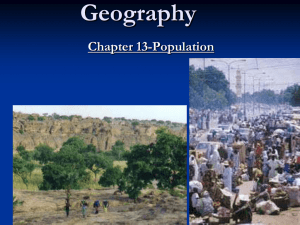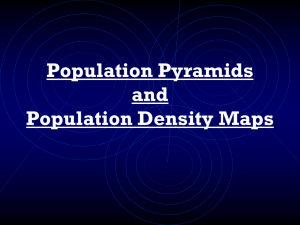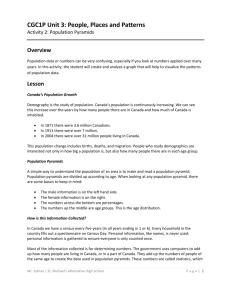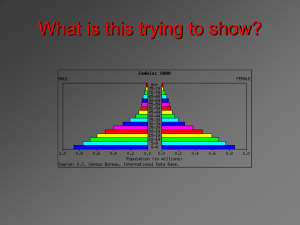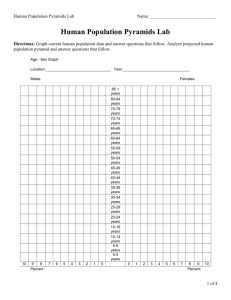Population Pyramids
advertisement
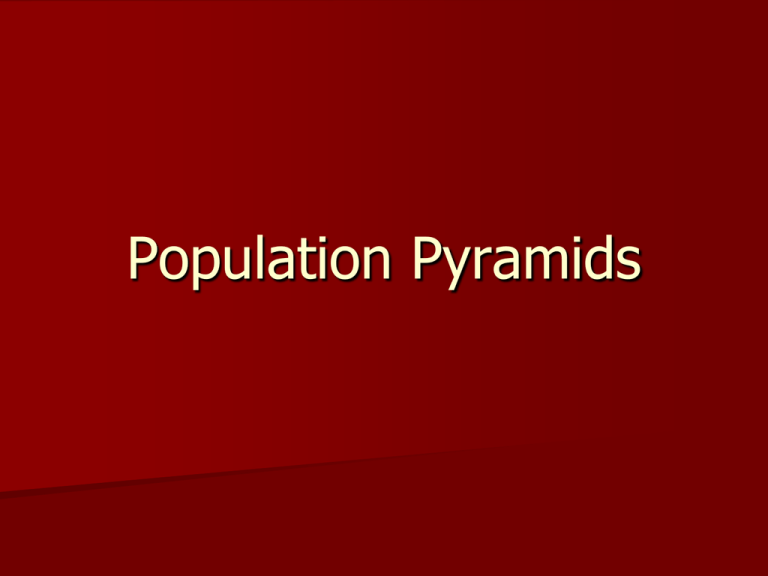
Population Pyramids Population Pyramids A special graph that shows the make-up of a population by age and gender. Cohorts A specific portion of the population that is combined together in an age group for the purposes of simplifying a population pyramid. Five-year cohorts are commonly used in population pyramids. The pattern that is created gives clues to the nature of country’s population. The percentage of males is plotted on the left The percentage of females is plotted on the right 3 Types of Population Pyramids 1) Increasing Population: A pyramid with a wide base and narrower top. This indicates a high birth rate and an expanding population. 2) Stable Population: A pyramid that indicates no or very little population growth. The pyramid is characterized by relatively straight sides. 3 Types of Population Pyramids 3) Decreasing Population: A pyramid with a narrow base and a narrow top. This indicates low birth rate and high death rate. Different Ages—Different Roles Children (under 15) Working Adults (16-64) Older adults (65+) Dependency Load: people under the age of 15 and over the age of 65. These people are usually not active income earners and are often supported by family members, pensions or retirement earnings. Working Population: this is the actively working population. Usually people between the ages of 15 and 64. Dependency Ratio The ratio between the number of dependants (anyone above or below the working age) and the number of people in the potential labour force. This ratio gives an indication of the level of economic development in the country as the higher the percentage of people of working age a country has the better off economically they should be. young dependants (YD): Anyone younger than 15 old dependants (OD): Anyone 65 and older Dependency ratio = YD (%) + OD (%) People of working age (%) x 100 Demographic Transition A multi-staged model showing changes in population as a result of a country’s economic development. The model is based on the changing population of Western Europe during industrialization. 4 Stages of the Demographic Transition Model 1) Primitive: High birth & death rates, moderately high population growth, primitive health and medical conditions, low life expectancy rate, very poor standard of living, least developed countries (LLDCs). 2) Early Expanding: High birth rate, death rate drops dramatically, improved medical conditions, largely agricultural and rural population, large families, explosive population growth, less developed countries (LDCs). 4 Stages of the Demographic Transition Model (continued) 3) Late Expanding: Birth rate drops in response to high growth of stage 2, death rate continues to drop slowly, improved standard of living & change in societal values, birth control improved, women join the labour force, more urban nation (less rural), more manufacturing & industry, smaller families, total population growth is moderate and lowering. 4) Zero Growth: Low birth & death rates, good medical & health conditions, long life expectancy, high standard of living, little population growth occurs-approaching zero population growth rate/ negative population growth, more developed countries (MDCs). Population Pyramid Activity Canada’s Dependency Ratio in 2006 Young dependants = young males (2.7% + 2.9% + 3.4%) + young females (2.6% + 2.8% + 3.2%) = 17.6% Old dependants = old males (1.9% + 1.6% + 1.2% + 0.8% + 0.5%) + old females (2% + 1.8% +1.6% + 1.3% + 1.1%) People of working age = Dependency ratio = = 13.8% 100% - (17.6% + 13.8%) = 68.6% YD (%) + OD (%) People of working age (%) x 100 Canada’s Dependency Ratio for 2006 = ( (17.6% + 13.8%)/ 68.6% ) x 100 = 45.8 per 100 workers Canada is in Stage 4 of the Demographic Transition Model Because: Low birth & death rates Good medical & health conditions Long life expectancy High standard of living Little / negative population growth occurs More developed country (MDC). Animated Canadian Population Pyramids http://www12.statcan.ca/censusrecensement/2006/as-sa/97551/tables-tableaux-noteseng.cfm#animations Population Pyramids of the World http://populationpyramid.net/ Review Population Pyramids 3 Types Dependency Ratio Demographic Transition Model 4 (or 5) Stages of the Demographic Transition Model

